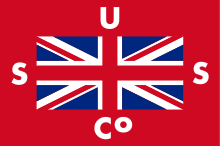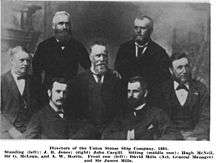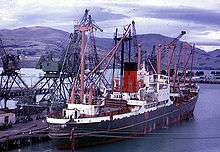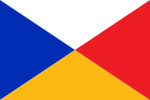Union Company

.jpg)

.jpg)
Union Steam Ship Company of New Zealand Limited —when there was no chance of confusion casually referred to as Union, Union Company, Union Steam Ship Company (USS Co), or Union Line— was once the biggest shipping line in the southern hemisphere and New Zealand's largest private-sector employer. It was incorporated by James Mills in Dunedin in 1875 with the backing of a Scottish shipbuilder, Peter Denny.[1] Bought by shipping giant P & O around the time of the First World War it was sold in 1972 to an Australasian consortium and closed at the end of the twentieth century.
History
James Mills had worked for Johnny Jones and his Harbour Steam Company. After Jones’ death in 1869 Mills tried twice to float a Union Steam Ship Company of New Zealand Limited without attracting enough interest from local investors but in 1875 he found backing from Scottish shipbuilder Peter Denny in return for Union Steam Ship orders for Denny's Dumbarton shipyard. The Denny-built Hawea and Taupo, both then large by local standards, arrived in mid 1875 and entered service. Union Steam Ship took over the Harbour Steam Company's vessels on 1 July 1875.[2]
Local competition
Union Steam Ship became a major shipping line dubbed "The Southern Octopus" with a near-monopoly on trans-Tasman shipping.[1] It steadily mopped up trans-Tasman and coastal shipping businesses including Anchor, Canterbury Steam, Richardson & Co and Holm.
Trans-Tasman
From 1889 there was three-way competition between Union Steam Ship, Huddart Parker and Tasmanian Steam Navigation Company (TSNCo) on the Tasmanian routes (Melbourne – Launceston, Hobart – Melbourne and Hobart – Sydney). TSNCo did not have other routes to absorb their Tasmanian losses and was bought out by USSCo in 1891. The rivalry between USSCo and Huddart Parker lasted to 1895 despite an earlier agreement in 1893. There was undercutting of fares and there were steamers shadowing each other from port to port. USSCo's Rotomahana and Mararoa would sail alongside the Miowra and Warrimoo, with other ships like the Te Anau and Manapouri sailing before and after and bracketing the Huddart Parker ships. The 1895 agreement between the two lines pooled the Auckland-Sydney profits and losses; the Melbourne-Launceston profits were divided 4/7 to USSCo and 3/7 to Huddart Parker. The Sydney-Hobart passenger trade was excluded but the cargo and stock trade was divided 2/3 to USSCo and 1/3 to Huddart Parker.[3] Mark Twain criticised travel conditions on a Union Company ship in 1897 in his travel book Following the Equator.
Mills was knighted in 1907 and raised to K.C.M.G. in 1909. He was a UK resident after 1907 and died in London in 1936. By 1914 Union Steam Ship had 75 ships. It was the biggest shipping line in the southern hemisphere and New Zealand's largest private-sector employer.[1]

P & O
In 1917 P & O shareholders were asked to confirm their directors' prior purchase of Union Steam Ship with the information that USSCo had a valuable coasting trade within New Zealand, connections with India and Australia and a line of steamers running between Australia, New Zealand and Canada. The Union Steam Ship fleet was described as 74 high class steamers with a tonnage of 237,860 and of an average age of 12 years.[4]
Union Airways
In the 1930s Union Airways of New Zealand was formed by Union Steam Ship and it built an air service through New Zealand. Union Airways was nationalised by the government in 1947 and renamed National Airways Corporation.
Union Travel
Union Travel remained a substantial operation as travel agents and tour operators.
T N T
Australian road transport business, Thomas Nationwide Transport, had a substantial road transport stake in New Zealand. With New Zealand investors TNT bought USSCo from P & O in 1971.[5]
In 1990 Union Steam Ship operated seven ships, and was involved in ship management, tourism, real estate and other ventures. By 2000, the Union Bulk[6] barge made its last voyage.[7]
Brierley Investments
At the end of the 20th century Brierley's bought all the shares, broke Union Steam Ship into components and sold up what it could.
Union Steam Ship Company of New Zealand owned more than 350 ships and has been the subject of a number of books.
.jpg)
Ferries
Steamer Express Wellington to Lyttelton
Union Steam Ship began regular sailings between Wellington and Lyttelton in 1895 with the Penguin making two round trips a week. In 1905 this became a daily service year round. In 1933 the name "Steamer Express" was adopted for the service.[8] Over the years a number of ships were used, including two Maoris, two Wahines, two Rangatiras, and a Hinemoa.[9]
TEV Wahine entered service in 1966 and foundered and sank at the mouth of Wellington Harbour in 1968. The TEV Rangatira entered service in 1972 and was withdrawn in 1976, bringing the Wellington–Lyttelton "Steamer Express" to an end.[8]

Wellington to Picton
In what has been described as "a fatal mistake",[10] Union Steam Ship announced in 1956 that the Tamahine was to be withdrawn from the Wellington-Picton route in 1962 and unlikely to be replaced (despite an offer of a $3 million government loan).[11] The designer of the replacement ferry(GMV Aramoana) recalled that, "The media said the whole thing was a red herring", adding, "In their view, if the Union Steam Ship Company couldn’t make the service pay, Railways definitely couldn’t."[12]
Fleet
| Name | Built | In service | Gross tonnage | Notes |
|---|---|---|---|---|
| SS Aorangi (1883) | 1883 | 1883–1915 | 4,163 GT | Sunk 10 August 1915 at Scapa Flow |
| MV Aorangi (1924) | 1924 | 1924–1953 | 17,491 GT | Arrived 25 July 1953 at Clydeside for breaking up |
| TSS Arahura | 1905 | 1905–1926 | 1,607 GT | |
| SS Hauroto | 1882 | 1882–1915 | 1,988 GT | Missing off the China sea after acquisition by Hauroto Steamship Co. Ltd., Hong Kong |
| TEV Hinemoa | 1946 | 1947–1967 | 6,911 GT | |
| SS Maheno | 1905 | 1905–1935 | 5,323 GT | |
| TSS Maori | 1906 | 1907–1946 | 3,399 GT | |
| TEV Maori | 1952 | 1953–1972 | 8,303 GT | |
| SS Marama | 1907 | 1907–1937 | 6,437 GT | |
| SS Makura | 1908 | 1908–1937 | 8,075 GT | Arrived 8 April 1937 at Shanghai for breaking up |
| TSS Maunganui | 1911 | 1911–1957 | 7,527 GT | Sold 1948 as SS Cyrenia; arrived 1957 at Savona for breaking up |
| SS Monowai | 1925 | 1925–1960 | 10,852 GT | Ex-SS Razmak (1925-1930); sold 1960 in Hong Kong for breaking up |
| SS Penguin | 1864 | 1879–1909 | 874 GT | Sunk 12 February 1909 off Cape Terawhiti; 75 deaths |
| TEV Rangatira | 1930 | 1931–1965 | 6,152 GT | |
| TEV Rangatira | 1971 | 1972–1976 | 9,387 GT | |
| RMS Tahiti | 1904 | 1904–1930 | 5,323 GT | Ex-RMS Port Kingston (1904-1911); sunk 12 August 1930 off Rarotonga; no death |
| SS Tararua | 1864 | 1864–1881 | 563 GT | Sunk 29 April 1881 off Waipapa Point; 131 deaths |
| TSS Wahine | 1912 | 1913–1951 | 4,436 GT | Ran aground on the Masela Island Reef off Cape Palsu in the Arafura Sea |
| TEV Wahine | 1966 | 1966–1968 | 8,948 GT | Sunk 10 April 1968 after hitting Barrett Reef during an extra-tropical cyclone; 53 deaths. |
| SS Waihora | 1882 | 1882–1903 | 2,003 GT | |
| SS Waihora | 1907 | 1907–1927 | 4,638 GT | |
| SS Wairarapa | 1882 | 1882–1894 | 1,786 GT | Sunk 29 October 1894 off Great Barrier Island; 140 deaths |
See also
| Wikimedia Commons has media related to Union Steam Ship Company of New Zealand. |
- Union Airways of N.Z. Ltd — Union Line's airline subsidiary
Notes
- 1 2 3 McLean, Gavin (20 November 2013). "Mills, James". Te Ara – the Encyclopedia of New Zealand.
- ↑ New Zealand Times 30 June 1875, page 2
- ↑ McLean 1990, pp. 49–66.
- ↑ Company Meetings, The Times, Thursday, Jun 28, 1917; pg. 11; Issue 41516
- ↑ Bids Deals and Mergers. The Times, Saturday, Sep 05, 1970; pg. 16; Issue 57963
- ↑ "New Zealand Maritime Index from NZNMM". www.nzmaritimeindex.org.nz. Retrieved 2016-03-29.
- ↑ "Union Steam Ship Company flag - NZHistory, New Zealand history online". www.nzhistory.net.nz. Retrieved 2016-03-29.
- 1 2 "Steamer Express". New Zealand Coastal Shipping. Retrieved 8 February 2015.
- ↑ McLean, Gavin (13 July 2012). "Shipping - The Union Company expands". Te Ara – the Encyclopedia of New Zealand.
- ↑ McLean, Gavin (2009). A Voice for Shipping (PDF). New Zealand Shipping Federation Inc. p. 60. ISBN 978-1-877448-76-8.
- ↑ "COOK STRAIT RAIL FERRIES - The New Zealand Maritime Record - NZNMM". www.nzmaritime.co.nz. Retrieved 2016-03-29.
- ↑ "Cook-Strait ferries changed the nature of shipping in New Zealand" (PDF). The Marlborough Express. 2012.
Bibliography
- Farquhar, Ian (2001). Union Fleet. Wellington, NZ: New Zealand Ship & Marine Society. ISBN 0959783474.
- McGregor, Rae (2009). Sailing to Success: The Union Company Cadet Scheme. Wellington, N.Z.: New Zealand Ship & Marine Society on behalf of Union Company Cadets Reunion Committee. ISBN 9780473152178.
- McLean, Gavin (1989). Ships of the Union Company. Wellington, NZ: GP Government Print. ISBN 0-477-00016-9.
- McLean, Gavin (1990). The Southern Octopus. Wellington, NZ: New Zealand Ship and Marine Society & Wellington Maritime Museum. ISBN 0959783431.
- McLauchlan, Gordon (1987). The Line that Dared: A history of the Union Steam Ship Company 1875–1975. Auckland: Four Star Books. ISBN 0-9597853-0-2.
External links
- Article in 1966 Encyclopaedia of New Zealand
- Article in Te Ara online Encyclopaedia
- Union Steam Ship Company by Gavin McLean on New Zealand Ship & Marine Society website
- Lyttelton-Wellington ferries (NZHistory.net.nz)
- colour photo of ferries Rangatira and Maori at Picton in 1959
